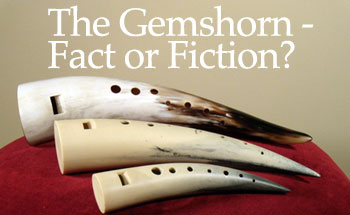The Medieval Gemshorn
- How much of what we see is fact and how much is fiction?
- Did the gemshorn even exist in the Middle Ages?
- Are families of gemshorns (soprano, alto, tenor, and bass) historically correct or a figment of our imagination?
It is impossible to produce an exact copy of a medieval gemshorn for two reasons — only two unplayable instruments survive and there are only a few very vague drawings from 16th-century sources. There are no extant medieval depictions of gemshorns and no contemporary descriptions of them. The surviving specimens are unplayable and undated. (No. 3436 in the Musical Instrument Museum of the Staatliches Institut für Musickforschung in Berlin). Curt Sachs examined a gemshorn in the Bach-Haus at Eisenach back in 1913, but it has since disappeared.
An instrument found in 1908 currently in the Museo Nazionale di Arti e Tradizioni Popolari di Roma is unplayable. Another instrument found in the ground under a timbered house dated about 1455 was fired from clay. Both of these instruments have only four holes in the top, and one in the back.
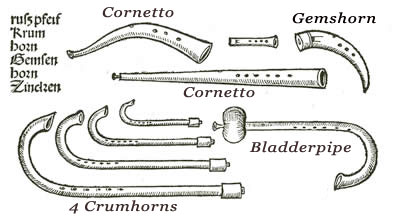
There is a depiction of a gemshorn in Sebastian Virdung's Musica Getutscht und Ausgezogen published in 1511, shown at left. This is the first known clear illustration. By the mid sixteenth century the instrument was no longer used. Both Virdung and Agricola describe the Gemshorn as a Blockflöte (recorder) in the form of a short, curved animal horn, with four finger holes.1
Reconstructions by Andrew Parkinson have demonstrated that by building a Gemshorn with only four holes (one thumb hole and three front-lateral handle holes), it is possible to play an octave.2
Herbert Meyers 3 suggests that the it was only of "peripheral" importance in the Middle Ages and was unlikely to have possessed the recorder-like fingering system given it by modern builders, and even less likely to have been built in families.
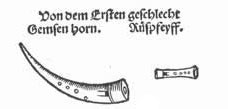
Other illustrations also show a horn with only four holes. Modern makers bore seven holes in the front and one in the back. It makes sense to assume that instrument makers in antiquity would try to get the maximum number of notes possible from the instrument, and there are too few surviving descriptions to say with certainty that every gemshorn only had four holes. The body of the instrument is an animal horn with the cross-section of an oblate spheroid. Acoustically, there are only a few things you can do with this shape. By plugging one end and carving a lip, you get the fundamental tone of the instrument. Boring eight holes allows the player to get different notes, but only in the range of a ninth. It can't be overblown to get higher notes, so that's about it.4
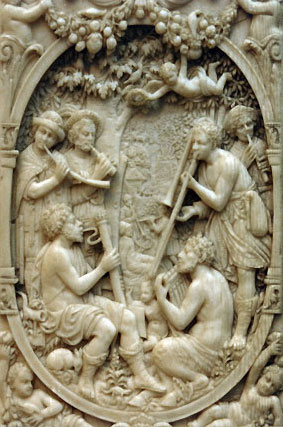
The ivory carving at the extreme left depicts, in the lower left hand corner, a signal horn or hunting horn, and is the type of horn that is usually found in medieval and renaissance art. A hunting horn can usually be identified by the trumpet-style mouthpiece, the open end, and no fingerholes. I have seen this instrument erroneously identified as a gemshorn on other websites. As far as I have been able to determine, there are no medieval depictions of gemshorns (before 1511).
The photo at the top of this page shows a tenor gemshorn made from cow's horn and two smaller gemshorns, a soprano and an alto. Makers today build them in almost as many sizes as recorders. I have even seen bass and sub-bass gemshorns! I suppose there is a certain logic in the assumption that Renaissance instrument makers would have built gemshorns in families (tuned to each other), since they built many other instruments in families, but there is absolutely no evidence for matched sets of satb gemshorns.
The question remains, was the gemshorn in common use during the Middle Ages, or was it as rare then as it is now? Was it in fact only known after about 1500, that is, as an uncommon Renaissance instrument that didn't survive more than half a century? Are matched sets of satb and greatbass gemshorns a figment of our imagination? And why should we care? Does it really matter that there is no evidence for a gemshorn quartet? It matters because if we are going to start building imaginary instruments for the performance of early music, then why stop there? Why not just reverse engineer all of our instruments to perform the way we want them to, instead of the way they were actually used and sounded? I think the answer to that is pretty obvious.
By the by--I like my little set of gemshorns. They are not tuned to each other but simply represent different sizes that may have been possible, since the horn material was available in different sizes. The number of holes of course is a matter of conjecture.
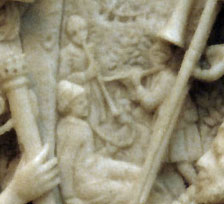
1) Agricola (1486-1556) Musica Instrumentalis Deudsch, 1529.
2) Early Music magazine.1981; 9: 43-46
3) Meyers, Herbert A Performers Guide To Medieval Music: Winds, Indiana University Press, 2000. f381
4) Fletcher, N.H., and Rossing, T.D. (1991). The Physics of Musical Instruments, 2nd ed. Springer-Verlag, Berlin and New York, 1998.
Above left is Christof Angermair’s ivory carving (1618-1624) from the coin cabinet of Elizabeth of Lorraine. (Munich: Bayerische Staatsgemäldesammlung; Salmen, Gartenmusik 75; Hindley 164). Clockwise, it depicts a bass recorder, curved cornett, racket, sackbut (trombone), straight cornet, and pan pipes. An unplayed hunting horn lays on the ground at the bottom left. The trombone player has a bagpipe (a hummelchen?) on his belt. Three musicians in the distant background are holding what appear to be a shawm, a flute, and a crumhorn. Click on the image at left to see a high-resolution photo of this magnificent ivory carving.
|

